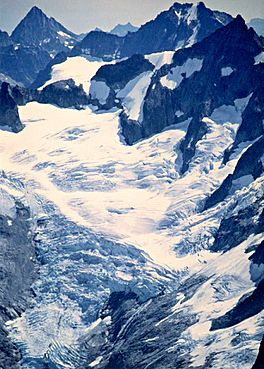Forbidden Glacier facts for kids
Quick facts for kids Forbidden Glacier |
|
|---|---|

Forbidden Glacier
|
|
| Type | Mountain glacier |
| Location | North Cascades National Park, Skagit County, Washington, U.S. |
| Coordinates | 48°31′03″N 121°03′44″W / 48.51750°N 121.06222°W |
| Length | .75 mi (1.21 km) |
| Terminus | Icefall/barren rock |
| Status | Retreating |
Forbidden Glacier is a fascinating ice formation located in the North Cascades National Park in the state of Washington, U.S.. It sits on the northern slopes of a tall mountain called Forbidden Peak. This glacier is like a slow-moving river made of ice.
Glaciers are huge bodies of ice that form over many years. They are created when snow falls and compacts into ice. Over time, this ice becomes so thick and heavy that it starts to flow slowly, like a very thick liquid.
Contents
What is Forbidden Glacier?
Forbidden Glacier is about .75 mi (1.21 km) (1.2 kilometers) long. At its widest point, it stretches about 1 mi (1.6 km) (1.6 kilometers) across. This icy giant flows down from high up in the mountains, starting at about 8,000 ft (2,400 m) (2,400 meters) and ending at around 5,600 ft (1,700 m) (1,700 meters).
Where is Forbidden Glacier Located?
Forbidden Glacier is found in the beautiful North Cascades National Park. This park is known for its rugged mountains and many glaciers. It is located in Skagit County, Washington. The glacier is nestled among some of the highest peaks in the North Cascades.
How Does Forbidden Glacier Form?
Glaciers like Forbidden Glacier form in places where more snow falls in winter than melts in summer. Each year, new layers of snow pile up. The weight of the new snow squeezes the older snow beneath it. This pressure turns the fluffy snow into dense, hard ice. Over hundreds or thousands of years, this ice builds up and begins to move.
The Movement of Glaciers
Even though they look still, glaciers are always moving. They slide very slowly down mountainsides due to gravity. This movement can carve out valleys and shape the landscape over long periods.
Features Around Forbidden Glacier
Forbidden Glacier is surrounded by interesting natural features. To its east and south, it is separated from another large glacier, Boston Glacier, by a sharp, rocky ridge. This ridge is called an arête. An arête is a narrow, knife-like ridge of rock. It forms when glaciers erode rock on both sides of a mountain.
Moraine Lake and Meltwater
As the ice of Forbidden Glacier slowly melts, its water flows into a nearby body of water. This water forms Moraine Lake. Meltwater from glaciers is an important source of fresh water for rivers and streams. It also helps to support plants and animals in the surrounding ecosystem.
The Status of Forbidden Glacier
Scientists observe that Forbidden Glacier is currently "retreating." This means the glacier is getting smaller. It is melting faster than new snow and ice can build up. Many glaciers around the world are retreating due to changes in Earth's climate. Studying glaciers like Forbidden Glacier helps scientists understand how our planet is changing.
Why Glaciers are Important
Glaciers are very important for several reasons:
- Freshwater Storage: They store a huge amount of the world's freshwater. This water is released slowly as meltwater, feeding rivers and lakes.
- Climate Indicators: Glaciers act like giant thermometers. Their size and movement can tell scientists a lot about past and present climate conditions.
- Ecosystems: Meltwater from glaciers creates unique habitats for plants and animals.


